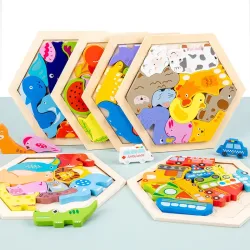Key aspects of wooden puzzles
2024-01-26
Wooden puzzles are popular and timeless toys that provide both entertainment and cognitive benefits. These puzzles come in various forms, from simple jigsaw puzzles for young children to intricate brain teasers for adults. Here are some key aspects of wooden puzzles:
1. Types of Wooden Puzzles:
- Jigsaw Puzzles: Pieces interlock to form an image, encouraging visual-spatial skills. Jigsaw puzzles come in various difficulty levels and themes, catering to different age groups.
- Educational Puzzles: These often feature numbers, letters, shapes, or animals, helping young children learn while playing.
- 3D Puzzles: Wooden puzzles can be designed to create three-dimensional structures, enhancing problem-solving skills.
- Brain Teasers: Intricate puzzles that challenge adults' problem-solving abilities. They may involve disentangling pieces, assembling complex shapes, or solving mathematical challenges.
2. Material:
- Wood: Wooden puzzles are crafted from high-quality wood, providing durability and a classic feel. The smooth finish and tactile nature of wooden pieces add to the overall sensory experience.
3. Age Appropriateness:
- Choose puzzles that are age-appropriate and match the developmental level of the intended user. Some puzzles are specifically designed for toddlers, preschoolers, or older children.
4. Difficulty Level:
- Puzzles come in varying difficulty levels, allowing users to choose a challenge that suits their skills. Beginner puzzles may have larger pieces and simpler shapes, while advanced puzzles may involve intricate patterns and smaller pieces.
5. Themes and Designs:
- Wooden puzzles come in a wide range of themes, including animals, nature, vehicles, and characters. Choose a puzzle with a theme that interests the user for added engagement.
6. Size and Pieces:
- Consider the size of the puzzle pieces, especially for younger children. Larger, chunky pieces are suitable for toddlers, while smaller pieces with more complex shapes are suitable for older children and adults.
7. Educational Value:
- Many wooden puzzles offer educational benefits, helping with cognitive development, fine motor skills, and problem-solving abilities. Educational puzzles often incorporate elements of counting, alphabet learning, or shape recognition.
8. Storage and Organization:
- Some wooden puzzles come with their storage boxes or trays to keep pieces organized. This is helpful for easy cleanup and ensures that pieces are not lost.
9. Safety Considerations:
- Ensure that the puzzles meet safety standards, especially for young children. Pieces should be large enough to avoid choking hazards, and any paint or finish used on the puzzle should be non-toxic.
10. Collaborative Play:
- Wooden puzzles can be enjoyed individually or as a group. Collaborative play promotes teamwork, communication, and social interaction.
11. Customizable Puzzles:
- Some companies offer personalized wooden puzzles with custom images or names, making for unique and thoughtful gifts.
Wooden puzzles provide a timeless and enjoyable way to engage the mind and enhance various skills. They are suitable for individuals of all ages and make for excellent educational tools and recreational activities.



